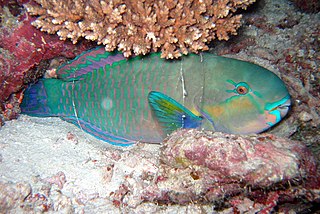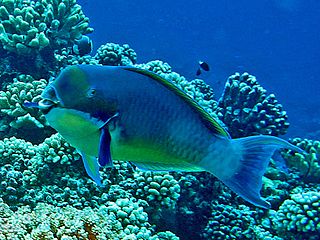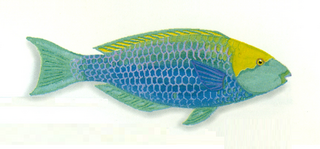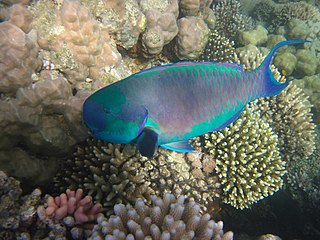
Parrotfish are a group of fish species traditionally regarded as a family (Scaridae), but now often treated as a subfamily (Scarinae) or tribe (Scarini) of the wrasses (Labridae). With roughly 95 species, this group's largest species richness is in the Indo-Pacific. They are found in coral reefs, rocky coasts, and seagrass beds, and can play a significant role in bioerosion.

Thalassoma bifasciatum, the bluehead, bluehead wrasse or blue-headed wrasse, is a species of marine ray-finned fish, a wrasse from the family Labridae. It is native to the coral reefs of the tropical waters of the western Atlantic Ocean. Individuals are small and rarely live longer than two years. They form large schools over the reef and are important cleaner fish in the reefs they inhabit.

The green humphead parrotfish is the largest species of parrotfish, growing to lengths of 1.5 m (4.9 ft) and weighing up to 75 kg (165 lb).

The marbled parrotfish, also known as the seagrass parrotfish, is a species of marine ray-finned fish, a parrotfish from the family Scaridae and is the only known member of the genus Leptoscarus. It has a wide Indo-Pacific distribution and is also found in the southeastern Atlantic Ocean. It is a coastal species found in beds of sea grass and seaweed.

The stoplight parrotfish is a species of marine ray-finned fish, a parrotfish from the family Scaridae, inhabiting coral reefs in Florida, Caribbean Sea, Gulf of Mexico, Bermuda and as far south as Brazil. It mainly feeds on algae by scraping and excavating it with its teeth. Like most of its relatives, it is able to change sex.

Cetoscarus bicolor, also known as the bicolour parrotfish or bumphead parrotfish, is a species of fish belonging to the family Scaridae. It is found only in the Red Sea.

The rusty parrotfish is a species of marine ray-finned fish, a parrotfish belonging to the family Scaridae. It is associated with reefs in the north western Indian Ocean and the Red Sea.

The queen parrotfish is a species of marine ray-finned fish, a parrotfish, in the family Scaridae. It is found on reefs in the tropical West Atlantic Ocean and the Caribbean Sea. Other common names include blownose, blue chub, blue parrotfish, blueman, joblin crow parrot, moontail, okra peji and slimy head. The young males and adult female queen parrotfish are a reddish-brown color, and quite different in appearance from the bluish-green color of the final phase male. This is a common species throughout its range and the International Union for Conservation of Nature has rated its conservation status as "least concern".

Chlorurus sordidus, known commonly as the daisy parrotfish or bullethead parrotfish, is a species of marine fish in the family Scaridae.

Scarus tricolor, also known as the tri-colour parrotfish or three-coloured parrotfish, is a species of marine ray-finned fish, a parrotfish, in the family Scaridae. It has a wide Indo-Pacific distribution.

Chlorurus microrhinos, the blunt-head parrotfish or steephead parrotfish, is a species of marine ray-finned fish, a parrotfish from the family Scaridae. It is found in the Indo-Pacific region.

Calotomus carolinus, commonly known as Carolines parrotfish, is a species of marine ray-finned fish, a parrotfish, in the family Scaridae. It is also known as the starry-eye parrotfish, stareye parrotfish, bucktooth parrotfish, Christmas parrotfish or marbled parrotfish. Since the Calotomus carolinus is known across the Pacific, it also has its own name in many native languages for example, it is called a panuhunuhunu in the Hawaiian language.

Scarus prasiognathos, the Singapore parrotfish, is a species of marine ray-finned fish, a parrotfish, in the family Scaridae. It is native to the eastern Indian and western Pacific Oceans, where it lives in coral reefs.

Hipposcarus longiceps or Pacific longnose parrotfish is a species of marine ray-finned fish, a parrotfish in the family Scaridae. It is found in the eastern Indian Oceans and the western Pacific Ocean from the Cocos-Keeling Islands and Rowley Shoals in the eastern Indian Ocean to the Line and Tuamotu islands in the east, north to the Ryukyu Islands, south to the Great Barrier Reef and New Caledonia.

Chlorurus spilurus, known commonly as the Pacific daisy parrotfish or Pacific bullethead parrotfish and in Hawaiian called uhu, is a species of marine fish in the family Scaridae. The Pacific daisy parrotfish is widespread throughout the tropical waters of the Pacific.

Cetoscarus ocellatus, common name Spotted parrotfish, is a species of parrotfish belonging to the family Scaridae.

Scarus fuscopurpureus, common name purple-brown parrotfish, is a species of marine ray-finned fish, belonging to the class Actinopterygii. It is a parrotfish in the family Scaridae. It occurs in the western Indian Ocean, the Red Sea, the gulf of Aden and the Persain Gulf. Countries in which boarder these waters include, but are not limited to Egypt, Sudan, Saudi Arabia, Yemen, Kuwait, and the United Arab Emirates.

Chlorurus gibbus, the heavybeak parrotfish, gibbus parrotfish or Red Sea steephead parrotfish, is a species of marine ray-finned fish, a parrotfish from the family Scaridae. It is found in the Red Sea.

Scarus psittacus, the common parrotfish, is a species of marine ray-finned fish, a parrotfish, in the family Scaridae. Other common names for this species include the palenose parrotfish, Batavian parrotfish and the rosy-cheek parrotfish. It has a wide distribution in the Indo-Pacific region where it is associated with coral reefs. This species is utilised as food. It is the type species of the genus Scarus.

Scarus zelindae is a species of fish of the Scaridae family in the order Perciformes. This species of Parrotfish can be brown, blue, green, yellow, and purple and can change their colors several times throughout their lifetime. They live for about 5–7 years and can be found in the southwestern Atlantic Ocean, primarily in Brazilian waters.






















